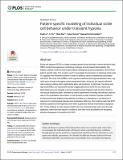| dc.contributor.author | Li, Xuejin | |
| dc.contributor.author | Suresh, Subra | |
| dc.contributor.author | Karniadakis, George Em | |
| dc.contributor.author | Du, E | |
| dc.contributor.author | Dao, Ming | |
| dc.date.accessioned | 2017-06-16T14:57:52Z | |
| dc.date.available | 2017-06-16T14:57:52Z | |
| dc.date.issued | 2017-03 | |
| dc.date.submitted | 2016-09 | |
| dc.identifier.issn | 1553-7358 | |
| dc.identifier.issn | 1553-734X | |
| dc.identifier.uri | http://hdl.handle.net/1721.1/109945 | |
| dc.description.abstract | Sickle cell disease (SCD) is a highly complex genetic blood disorder in which red blood cells (RBC) exhibit heterogeneous morphology changes and decreased deformability. We employ a kinetic model for cell morphological sickling that invokes parameters derived from patient-specific data. This model is used to investigate the dynamics of individual sickle cells in a capillary-like microenvironment in order to address various mechanisms associated with SCD. We show that all RBCs, both hypoxia-unaffected and hypoxia-affected ones, regularly pass through microgates under oxygenated state. However, the hypoxia-affected cells undergo sickling which significantly alters cell dynamics. In particular, the dense and rigid sickle RBCs are obstructed thereby clogging blood flow while the less dense and deformable ones are capable of circumnavigating dead (trapped) cells ahead of them by choosing a serpentine path. Informed by recent experiments involving microfluidics that provide in vitro quantitative information on cell dynamics under transient hypoxia conditions, we have performed detailed computational simulations of alterations to cell behavior in response to morphological changes and membrane stiffening. Our model reveals that SCD exhibits substantial heterogeneity even within a particular density-fractionated subpopulation. These findings provide unique insights into how individual sickle cells move through capillaries under transient hypoxic conditions, and offer novel possibilities for designing effective therapeutic interventions for SCD. | en_US |
| dc.description.sponsorship | United States. Department of Energy (DE-AC02- 06CH11357) | en_US |
| dc.language.iso | en_US | |
| dc.publisher | Public Library of Science | en_US |
| dc.relation.isversionof | http://dx.doi.org/10.1371/journal.pcbi.1005426 | en_US |
| dc.rights | Creative Commons Attribution 4.0 International License | en_US |
| dc.rights.uri | http://creativecommons.org/licenses/by/4.0/ | en_US |
| dc.source | PLoS | en_US |
| dc.title | Patient-specific modeling of individual sickle cell behavior under transient hypoxia | en_US |
| dc.type | Article | en_US |
| dc.identifier.citation | Li, Xuejin; Du, E.; Dao, Ming; Suresh, Subra and Karniadakis, George Em. “Patient-Specific Modeling of Individual Sickle Cell Behavior Under Transient Hypoxia.” Edited by Andrew D. McCulloch. PLOS Computational Biology 13, no. 3 (March 2017): e1005426. © 2017 Li et al. | en_US |
| dc.contributor.department | Massachusetts Institute of Technology. Department of Materials Science and Engineering | en_US |
| dc.contributor.mitauthor | Du, E | |
| dc.contributor.mitauthor | Dao, Ming | |
| dc.relation.journal | PLOS Computational Biology | en_US |
| dc.eprint.version | Final published version | en_US |
| dc.type.uri | http://purl.org/eprint/type/JournalArticle | en_US |
| eprint.status | http://purl.org/eprint/status/PeerReviewed | en_US |
| dspace.orderedauthors | Li, Xuejin; Du, E.; Dao, Ming; Suresh, Subra; Karniadakis, George Em | en_US |
| dspace.embargo.terms | N | en_US |
| dc.identifier.orcid | https://orcid.org/0000-0002-0301-0891 | |
| mit.license | PUBLISHER_CC | en_US |
